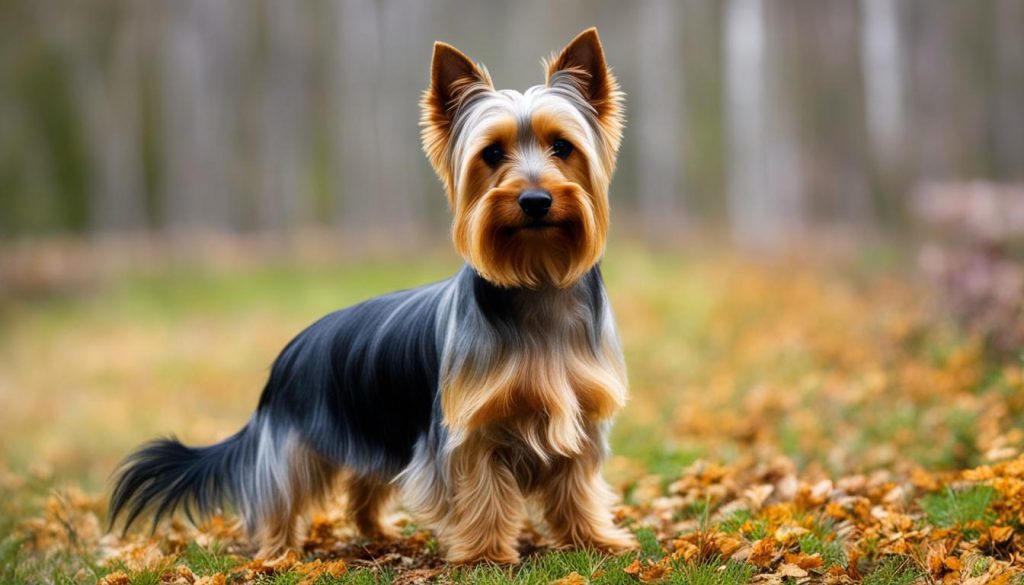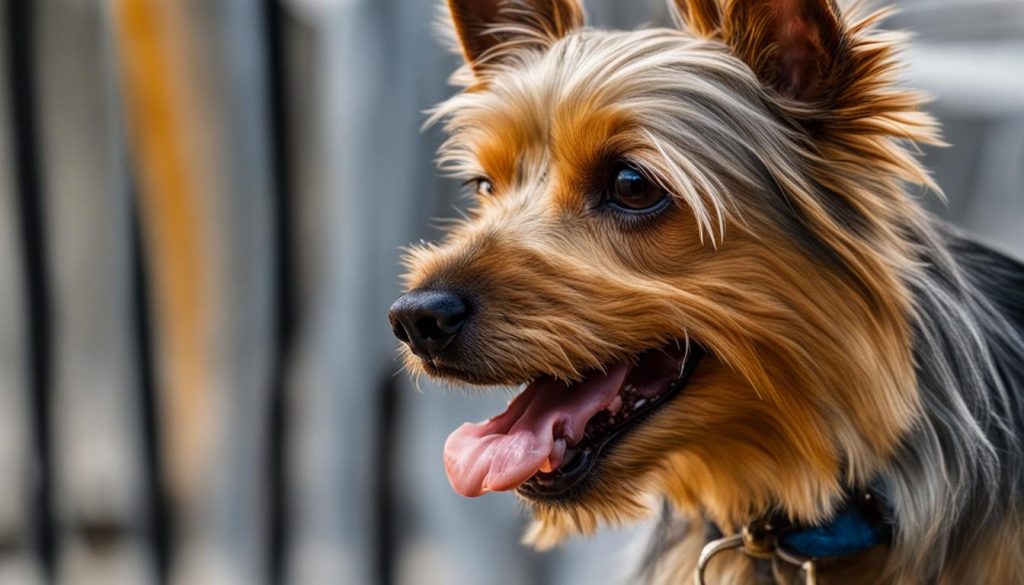Hello, fellow dog lovers! Today, I want to share some valuable tips for Silky Terrier training. Silky Terriers are an enchanting breed known for their elegant stature and spirited personality. Whether you’re a first-time dog owner or have had experience with other breeds, training your Silky Terrier requires a unique approach to bring out their best behavior and ensure a happy and harmonious bond between you and your furry friend.
When it comes to Silky Terrier training, positive reinforcement techniques are the way to go. These intelligent and energetic dogs respond best to rewards such as treats, praise, and play. It’s important to start training them from a young age to establish good habits and set the groundwork for obedience and socialization.
Silky Terrier Training
- Use positive reinforcement techniques, such as treats and praise, to train your Silky Terrier.
- Start training your Silky Terrier from a young age for better results.
- Early socialization is crucial for Silky Terriers to adapt well to different environments and experiences.
- Regular grooming is necessary to maintain their distinctive silky coat.
- Silky Terriers may be prone to certain health issues, such as patellar luxation, so regular vet check-ups are important.
The Origin and History of Silky Terriers
Silky Terriers have a fascinating history that can be traced back to a purposeful cross between Australian terriers and Yorkshire Terriers in the early 20th century. The Australian Terrier, known for its tenacity and adaptability, provided the foundation for the Silky Terrier’s enduring qualities. The infusion of Yorkshire Terrier genetics added a transformative aesthetic, resulting in a small-sized terrier with a striking, shimmering coat.
Physical Characteristics of Silky Terriers
Silky Terriers possess unique physical characteristics that contribute to their distinctive charm and allure. From their compact and well-proportioned body to their luxurious coat, they exude elegance and grace. Here are some key features that define the physicality of Silky Terriers:

Size
- Weighing between 8 and 11 pounds, Silky Terriers are small in size, making them an ideal breed for apartment living or households with limited space.
- Standing at 9 to 10 inches tall, they have a height that is both charming and manageable.
Coat
- The most recognizable aspect of Silky Terriers is their stunning coat, characterized by its silky texture and the mesmerizing combination of blue and tan colors.
- This luscious coat requires regular grooming to maintain its beauty and health.
Facial Features
- Silky Terriers have expressive eyes that captivate with their warmth and intelligence. Their eyes reflect their playful and curious nature.
- Their small triangular ears contribute to their overall charm, adding a touch of innocence to their appearance.
Additionally, Silky Terriers carry their tail high, which enhances their poise and elegance. Despite their dainty appearance, they possess a robust build, reflecting their strength and agility. These physical characteristics distinguish Silky Terriers and make them a breed to be admired.
Temperament and Personality Traits of Silky Terriers
Silky Terriers have a warm and affectionate nature, forming strong bonds with their owners. They are known for their intelligence, alertness, and eagerness to please. These dogs are energetic and playful, thrive on human companionship, and have a curious nature. Silky Terriers adapt well to different living situations and possess an independent spirit that adds to their overall charm.
When it comes to Silky Terrier temperament, they are friendly and outgoing, making them great family pets. Their affectionate nature makes them excellent companions, and they often become deeply attached to their owners. With their high level of intelligence, Silky Terriers are quick learners and are always eager to please.
One of the remarkable traits of Silky Terriers is their adaptability. They can thrive in various living situations, whether it’s a bustling city apartment or a spacious suburban home. Their curious nature makes them excellent explorers, always ready to investigate their surroundings. Despite their small size, Silky Terriers have an independent spirit that adds to their overall charm.
Silky Terrier Personality Traits:
- Intelligence: Silky Terriers are intelligent and quick learners.
- Playfulness: These dogs have a playful and energetic nature.
- Friendliness: Silky Terriers are friendly and get along well with people and other pets.
- Adaptability: They can adapt to different living situations and lifestyles.
Silky Terriers possess a warm and affectionate temperament, combined with intelligence and playfulness. They make loving companions and are well-suited for various living environments. Their independence and curiosity add to their unique charm and make them a delightful addition to any family.
Training Techniques for Silky Terriers
Silky Terriers are highly trainable dogs, and utilizing the right Silky Terrier training techniques is essential for their development and well-being. Positive reinforcement training methods work exceptionally well with these intelligent and eager-to-please breeds. By rewarding desired behaviors with treats, praise, or play, you can effectively motivate and encourage your Silky Terrier to learn and follow commands. Consistency is key in Silky Terrier training, as it helps establish clear boundaries and expectations for your furry friend.
Early socialization is crucial for Silky Terriers to ensure they become well-rounded and adaptable companions. Exposing them to different environments, people, and other animals from a young age will help them feel comfortable and confident in various situations. This early socialization lays a solid foundation for their future interactions and reduces the likelihood of fear or aggression issues.
Obedience training is an essential component of Silky Terrier training. Teaching them basic commands like sit, stay, come, and down is crucial for their safety and your peace of mind. Obedience training establishes a strong bond of trust and respect between you and your Silky Terrier, making it easier to manage their behavior both at home and in public.
While Silky Terrier training may present some challenges, the rewards of a well-mannered and responsive companion are immeasurable. It’s important to approach training sessions with patience, positivity, and a calm demeanor. Remember that each dog is unique, and progress may vary. Tailoring the training to suit your Silky Terrier’s individual needs and learning style will yield the best results.
In addition to traditional Silky Terrier training sessions, grooming sessions can also serve as valuable Silky Terrier training opportunities. Silky Terriers require regular grooming to maintain their luxurious coat. By incorporating training exercises into these sessions, such as practicing sitting or staying still, you can strengthen the bond between you and your Silky Terrier while ensuring they stay calm and cooperative during grooming.
Silky Terrier training is an ongoing process, and it is important to provide frequent opportunities for mental stimulation and physical exercise. Engaging in activities that challenge their minds, such as puzzle toys or scent games, can help prevent boredom and destructive behavior. Regular exercise, such as daily walks or play sessions in a secure area, is also vital for their overall well-being.
By utilizing positive reinforcement techniques, prioritizing early socialization, and incorporating obedience training into your Silky Terrier’s routine, you can create a harmonious and well-behaved companion that brings joy to your household.
Grooming Needs of Silky Terriers
Proper grooming is essential to keep your Silky Terrier looking and feeling their best. Regular grooming sessions will help maintain their lush, silky coat and ensure their overall health and hygiene. Here are some important grooming needs to consider:
- Silky Terrier Coat Brushing: Aim for two to three weekly brushing sessions using a slicker brush or comb. This will help prevent matting and keep their coat soft and tangle-free.
- Silky Terrier Bathing Routine: Bathing should be done every four to six weeks using a mild dog shampoo. Be sure to rinse thoroughly to remove all soap residue and maintain the natural oils in their coat.
- Silky Terrier Trimming and Shaping: Silky Terriers may require occasional trimming and shaping, especially around the paws and ears, to maintain their neat appearance.
- Silky Terrier Eye and Ear Care: Regular eye and ear care is important to prevent infections. Clean their eyes with a soft, damp cloth and check their ears for any signs of redness or discharge. If necessary, consult a veterinarian for appropriate ear cleaning solutions.
- Silky Terrier Dental Hygiene: Dental problems can be common in Silky Terriers, so it’s important to establish a dental hygiene routine. Brush their teeth regularly with a dog-specific toothbrush and toothpaste to prevent periodontal disease and tooth decay.
- Silky Terrier Nail Trimming: Trim your Silky Terrier’s nails regularly to keep them from becoming too long and causing discomfort. Be cautious when cutting the nails to avoid cutting into the quick.
By incorporating these grooming practices into your Silky Terrier’s routine, you can ensure they look their best and stay healthy. Grooming sessions also provide an opportunity for bonding and strengthen the relationship between you and your furry companion.
Common Health Issues in Silky Terriers
Silky Terriers, like any other breed, are susceptible to certain health issues. Understanding these common health concerns can help you provide the best care for your furry companion.
1. Patellar Luxation
Patellar luxation is a condition where the kneecap becomes dislocated from its normal position. Silky Terriers are prone to this condition, which can cause lameness and discomfort. Regular exercise, maintaining a healthy weight, and avoiding excessive jumping can help mitigate the risk of patellar luxation.
2. Tracheal Collapse
Tracheal collapse is a respiratory condition where the windpipe weakens and narrows, making breathing difficult for affected dogs. Silky Terriers are susceptible to this condition due to their small size and delicate trachea. Avoiding irritants such as smoke and excessive pulling on the leash can help manage tracheal collapse. Using a harness instead of a collar for walks may also be beneficial.
3. Dental Problems
Like many small dog breeds, Silky Terriers are prone to dental problems such as periodontal disease and tooth decay. Regular dental care, including daily tooth brushing and annual professional cleanings, can help prevent these issues. Providing appropriate chew toys and feeding a balanced diet also contribute to good dental health.
Regular veterinary check-ups are crucial for early detection and timely treatment of any health concerns. By staying proactive and addressing potential issues promptly, you can ensure the overall health and well-being of your Silky Terrier.

Conclusion
Silky Terriers are truly remarkable creatures, showcasing a unique combination of beauty, intelligence, and loyalty. These dogs make exceptional companions, thriving on human companionship and forming strong bonds with their owners. Their affectionate and friendly nature ensures they bring joy and happiness to any household.
However, it is important to note that Silky Terriers require proper care and attention to ensure their well-being. Training is crucial to channel their intelligent and energetic nature into positive behaviors. Positive reinforcement techniques are highly effective in shaping their behavior and obedience.
In addition to Silky Terrier training, Silky Terriers have specific grooming needs. Their luxurious coats require regular brushing to maintain their silky texture and prevent matting. Bathing and occasional trimming are also necessary to keep them looking their best. Regular veterinary care, including vaccinations and check-ups, is important to address any potential health issues and ensure their overall health.
All in all, with their stunning appearance, intelligence, and unwavering loyalty, Silky Terriers are indeed a breed worth considering. By providing them with proper care, love, and companionship, you will undoubtedly be rewarded with a lifelong friend who will fill your life with affection, laughter, and endless joy.
FAQ
What is the best training technique for Silky Terriers?
Positive reinforcement training techniques, such as rewarding desired behaviors with treats, praise, or play, work best for Silky Terriers.
When should I start training my Silky Terrier?
Training should start from a young age to establish good behavior and manners. Early socialization is also important to expose your Silky Terrier to different environments and experiences.
How often should I groom my Silky Terrier?
Silky Terriers require regular brushing, aiming for two to three sessions per week. Bathing should be done every four to six weeks, and occasional trimming and shaping may be necessary.
What are common health issues in Silky Terriers?
Silky Terriers can be prone to health issues such as patellar luxation, tracheal collapse, and dental problems. Regular veterinary check-ups and dental care are important for their overall health.
Are Silky Terriers good family pets?
Yes, Silky Terriers make excellent family pets. They are friendly, intelligent, and thrive on human companionship.
How much exercise do Silky Terriers need?
Silky Terriers require regular exercise to keep them physically and mentally stimulated. Daily walks, playtime, and interactive toys are recommended to meet their exercise needs.






